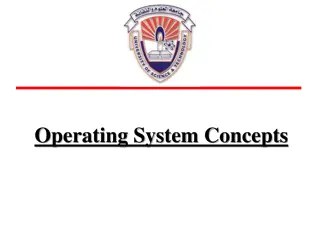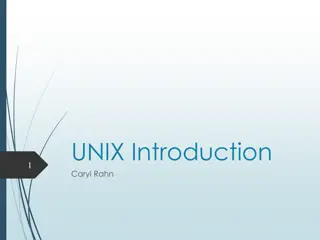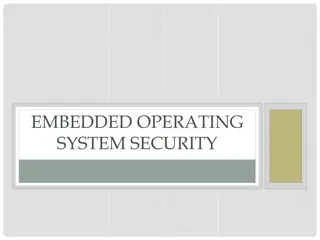Fundamentals of Operating Systems Explained
Explore the core concepts of operating systems, including kernel-userspace interactions, system calls, context switching, and virtual memory management. Delve into x86 assembly for system calls, hardware interrupts, and the flow of control during system call invocations. Gain insights into key components like the user space, kernel space, and the execution of syscalls in the operating system environment.
Download Presentation

Please find below an Image/Link to download the presentation.
The content on the website is provided AS IS for your information and personal use only. It may not be sold, licensed, or shared on other websites without obtaining consent from the author.If you encounter any issues during the download, it is possible that the publisher has removed the file from their server.
You are allowed to download the files provided on this website for personal or commercial use, subject to the condition that they are used lawfully. All files are the property of their respective owners.
The content on the website is provided AS IS for your information and personal use only. It may not be sold, licensed, or shared on other websites without obtaining consent from the author.
E N D
Presentation Transcript
CMSC421: Principles of Operating Systems Nilanjan Banerjee Assistant Professor, University of Maryland Baltimore County nilanb@umbc.edu http://www.csee.umbc.edu/~nilanb/teaching/421/ Principles of Operating Systems 1
Announcements Project 0 and Homework 1 out Discussion grades will not be on Blackboard Readings from Silberchatz Optional but important 2
Discussion 1 Sign bit exponent Mantissa 1000 *(int *)&a 1000 1000 Integer/2s compliment 3
Kernel-userspace interaction software interrupts system calls Hardware interrupts timers Application kernel exceptions Timers/return from sys call A closer look at system calls 4
Lets take an example main: OS _start libc linker assembler .s file .o file Exec. .c file libraries 5
X86 assembly for system calls (older mechanism) mov $1, %eax mov $25, %ebx int $0x80 Execute interrupt # 128 In the interrupt vector table Software interrupt Jump to an address in the kernel where the syscall table is stored And execute syscall # stored in %eax args for syscall in registers [ebx, ecx, edx, esi, edi] 6
Primer into virtual memory management Virtual addresses unallocated Physical addresses 7
Primer into kernel and user space memory Acknowledgement: http://duarts.org/gustavo/blog/category/internals 8
Primer into how context switching happens Acknowledgement: http://duarts.org/gustavo/blog/category/internals 9
Flow of control during a system call invocation library (libc) Return value Error = -1 Errorcode = errorno your system call invocation application User space int 0x80 Kernel space syscall_table.S iret entry_32.S Saves registers on stack Save return address of user process (thread_info) restore registers system call execution return value stored in the stack location corresponding to %eax table of function pointers 10
Kernel dive. 11
Important kernel files/ data structures for system calls implementation file for the sys call kernel/sys.c (most of the system calls are implemented) You can implement a system call anywhere include/asm-i386/unistd.h Defines the *number* of a system call Defined the total number of system calls. arch/i386/kernel/syscall_table.S Stores the system call table Stores the function pointers to system call definition 12
Using sysenter/sysexit in Linux > 2.5 Sysenter/sysexit is also called Fast system Call Available in Pentium II + Sysenter is made of three registers SYSENTER_CS_MSR -- selecting segment of the kernel code (figuring out which kernel code to run) SYSENTER_EIP_MSR --- address of the kernel entry SYSENTER_ESP_MSR --- kernel stack pointer 13
Simplified view of sysenter/sysexit in Linux > 2.5 library (libc) Return value Error = -1 Errorcode = errorno your _ _kernel_vsyscall application User space sysenter Kernel space syscall_table.S sysexit entry_32.S Saves user mode stack Save return address of user process (thread_info) restore registers system call execution return value stored in the stack location corresponding to %eax table of function pointers 14
Lets write a system call in the kernel (sys_strcpy) int strcpy(char *src, char *dest, int len) can return values of size of at most long? Why? asmlinkage long sys_strcpy(char *src, char *dest, int len) compiler directive params will be read from stack 15
Issues to think about when writing system calls Moving data between the kernel and user process Concerns: security and protection Synchronization and concurrency (will revisit) Several (so called) kernel threads might be accessing the same data structure that you want to read/write Simple solution (disable interrupts cli ) Usually not a good idea Big problem in preemptive CPU (which is almost every CPU) and multi-processor systems CONFIG_SMP or CONFIG_PREEMPT 16
Useful kernel API functions for bidirectional data movement access_ok (type, addr, size): type (VERIFY_READ, VERIFY_WRITE) get_user(x, ptr) --- read a char or int from user-space put_user(x, ptr) --- write variable from kernel to user space copy_to_user(to, from, n) --- copy data from kernel to userspace copy_from_user(to, from, n) copy data to kernel from userspace strnlen_user(src, n) checks that the length of a buffer is n strcpy_from_user(dest, src, n) ---copies from kernel to user space Acknowledgement: http://www.ibm.com/developerworks/linux/library/l-kernel-memory-access/index.html 17
Next class Linux Boot process How the first process gets started Process management Process creation and basic IPC: fork(), pipe(), dup2(), wait() Theory on processes 18
(a Microsoft Interview Question) An in-class discussion 19























